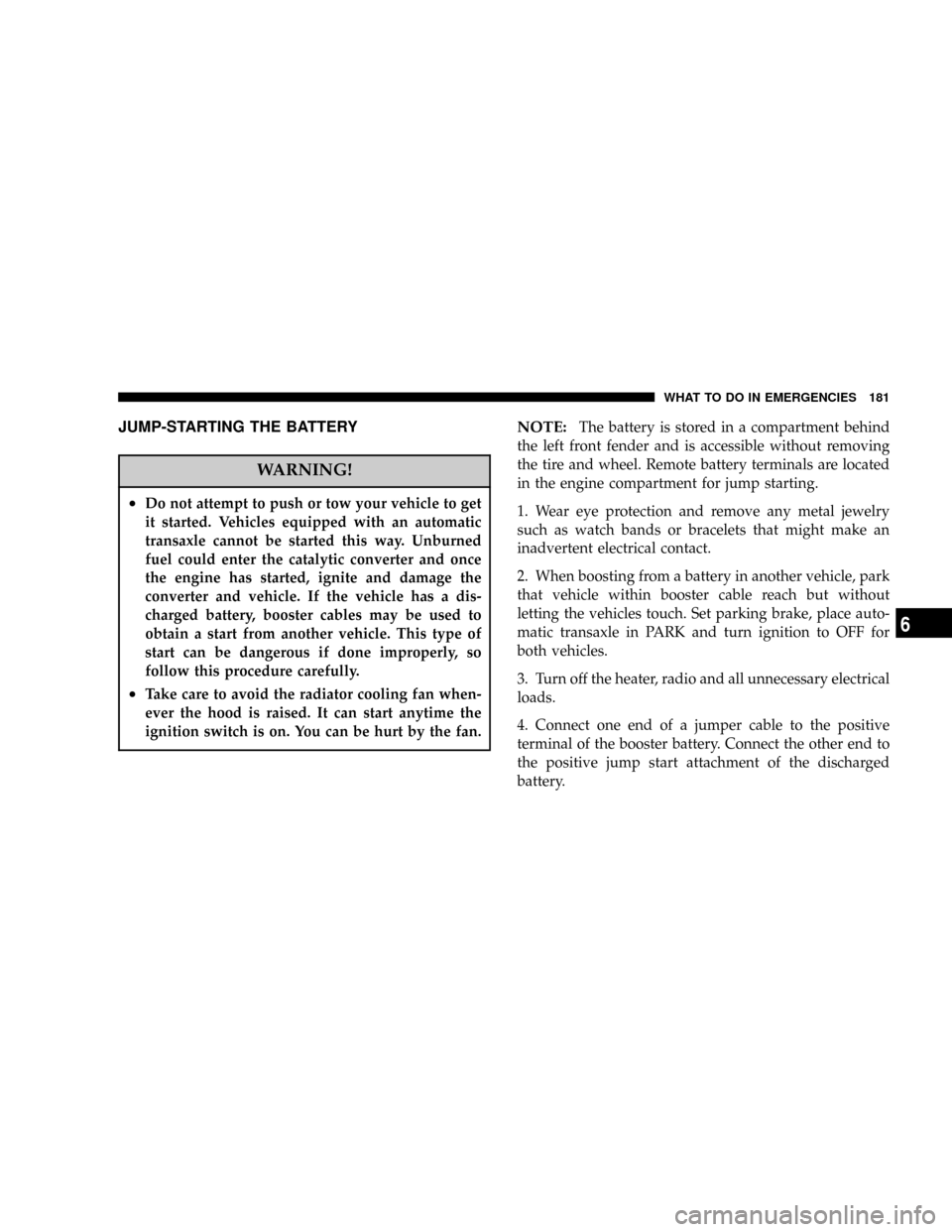CHRYSLER SEBRING CONVERTIBLE 2004 2.G Owners Manual
Manufacturer: CHRYSLER, Model Year: 2004, Model line: SEBRING CONVERTIBLE, Model: CHRYSLER SEBRING CONVERTIBLE 2004 2.GPages: 271, PDF Size: 5.31 MB
Page 181 of 271

JUMP-STARTING THE BATTERY
WARNING!
²Do not attempt to push or tow your vehicle to get
it started. Vehicles equipped with an automatic
transaxle cannot be started this way. Unburned
fuel could enter the catalytic converter and once
the engine has started, ignite and damage the
converter and vehicle. If the vehicle has a dis-
charged battery, booster cables may be used to
obtain a start from another vehicle. This type of
start can be dangerous if done improperly, so
follow this procedure carefully.
²Take care to avoid the radiator cooling fan when-
ever the hood is raised. It can start anytime the
ignition switch is on. You can be hurt by the fan.
NOTE:The battery is stored in a compartment behind
the left front fender and is accessible without removing
the tire and wheel. Remote battery terminals are located
in the engine compartment for jump starting.
1. Wear eye protection and remove any metal jewelry
such as watch bands or bracelets that might make an
inadvertent electrical contact.
2. When boosting from a battery in another vehicle, park
that vehicle within booster cable reach but without
letting the vehicles touch. Set parking brake, place auto-
matic transaxle in PARK and turn ignition to OFF for
both vehicles.
3. Turn off the heater, radio and all unnecessary electrical
loads.
4. Connect one end of a jumper cable to the positive
terminal of the booster battery. Connect the other end to
the positive jump start attachment of the discharged
battery.
WHAT TO DO IN EMERGENCIES 181
6
Page 182 of 271

WARNING!
Do not permit vehicles to touch each other as this
could establish a ground connection and person
injury could result.
5. Connect the other cable, first to the negative terminal
of the booster battery and then to the jump start attach-
ment of the vehicle with the discharged battery. Make
sure you have a good contact on the engine.
WARNING!
Do not connect the cable to the negative post of the
discharged battery. The resulting electrical spark
could cause the battery to explode.
During cold weather when temperatures are below
freezing point, electrolyte in a discharged battery
may freeze. Do not attempt jump starting because
the battery could rupture or explode. The battery
temperature must be brought up above freezing
point before attempting to jump start.
6. Start the engine in the vehicle that has the booster
battery, let the engine idle a few minutes, then start the
engine in the vehicle with the discharged battery.
7. When removing the jumper cables, reverse the above
sequence exactly. Be careful of the moving belts and fan.
182 WHAT TO DO IN EMERGENCIES
Page 183 of 271

WARNING!
Any procedure other than above could result in:
1. Personal injury caused by electrolyte squirting
out the battery vent;
2. Personal injury or property damage due to battery
explosion;
3. Damage to charging system of booster vehicle or
of immobilized vehicle.
WARNING!
Battery fluid is a corrosive acid solution; do not
allow battery fluid to contact eyes, skin or clothing.
Don't lean over battery when attaching clamps or
allow the clamps to touch each other. If acid splashes
in eyes or on skin, flush the contaminated area
immediately with large quantities of water.
A battery generates hydrogen gas which is flam-
mable and explosive. Keep flame or spark away
from the battery. Do not use a booster battery or any
other booster source with an output that exceeds 12
volts.
WARNING!
Battery posts, terminals and related accessories con-
tain lead and lead compounds. Wash hands after
handling.
WHAT TO DO IN EMERGENCIES 183
6
Page 184 of 271

DRIVING ON SLIPPERY SURFACES
Acceleration
Rapid acceleration on snow covered, wet, or other slip-
pery surfaces may cause the front wheels to pull errati-
cally to the right or left. This phenomenon occurs when
there is a difference in the surface traction under the front
(driving) wheels, particularly with high output engines.
WARNING!
Rapid acceleration on slippery surfaces is danger-
ous. Unequal traction can cause sudden pulling of
the front wheels. You could lose control of the
vehicle and possibly have an accident. Accelerate
slowly and carefully whenever there is likely to be
poor traction (ice, snow, wet, mud, loose sand, etc.).
Traction
When driving on wet or slushy roads, it is possible for a
wedge of water to build up between the tire and road
surface. This is hydroplaning and may cause partial or
complete loss of vehicle control and stopping ability. To
reduce this possibility, the following precautions should
be observed:
1. Slow down during rainstorms or when roads are
slushy.
2. Slow down if road has standing water or puddles.
3. Replace tires when tread wear indicators first become
visible.
4. Keep tires properly inflated.
5. Maintain enough distance between your vehicle and
the vehicle in front of you to avoid a collision in a sudden
stop.
NOTE:If so equipped, turn on the Traction Control
System to accelerate on slippery surfaces.
184 WHAT TO DO IN EMERGENCIES
Page 185 of 271

FREEING A STUCK VEHICLE
If your vehicle is equipped with Traction Control, turn
the system off before attempting to ªrockº the vehicle.
If your vehicle becomes stuck in mud, sand or snow, it
can often be moved by a rocking motion. Turn your
steering wheel right and left to clear the area around the
front wheels. Then shift back and forth between Reverse
and First gear. Usually the least accelerator pedal pres-
sure to maintain the rocking motion without spinning the
wheels is most effective.
CAUTION!
Racing the engine or spinning the wheels too fast
may lead to transaxle overheating and failure. It can
also damage the tires. Do not spin the wheels above
30 mph (48 km/h).
TOWING A DISABLED VEHICLE
Flat bed towing is the preferred towing method. If a flat
bed towing vehicle is not available, a wheel lift towing
vehicle may be used.
Rear towing is not recommended with the front wheels
on the ground, as transaxle damage can result. If rear
towing is the only alternative, a front end dolly must be
used.
CAUTION!
Do not use sling type towing equipment. Damage to
the fascia and air dam may result.
WHAT TO DO IN EMERGENCIES 185
6
Page 186 of 271

TOWING THIS VEHICLE BEHIND ANOTHER
VEHICLE (Flat towing with all four wheels on the
ground)
Automatic Transaxle
Your vehicle may be towed under the following condi-
tions: The gear selector must be in NEUTRAL, the
distance to be towed must not exceed 15 miles (25 km),
and the towing speed must not exceed 25 mph (40
km/h). If the transaxle is not operative, or if the vehicle
is to be towed more than 15 miles (25 km), the vehicle
must be towed with the front wheels off the ground.
Manual Transaxle
If your vehicle is equipped with a manual transaxle, it
may be towed at any legal highway speed, for any
distance, if the transaxle is in neutral.
All Transaxles
CAUTION!
If the vehicle being towed requires steering, the
ignition switch must be in the OFF position, not in
the LOCK or ACCESSORY positions.
If it is necessary to use the accessories while being towed
(wipers, defrosters, etc.), the key must be in the ON
position, not the ACCESSORY position. Make certain the
transaxle remains in NEUTRAL.
186 WHAT TO DO IN EMERGENCIES
Page 187 of 271

MAINTAINING YOUR VEHICLE
CONTENTS
m2.4L Engine..........................189
m2.7L Engine..........................190
mOnboard Diagnostic System Ð OBD II......191
mEmissions Inspection And Maintenance
Programs
............................192
mReplacement Parts.....................193
mDealer Service........................193
mMaintenance Procedures.................194
NEngine Oil..........................194
NCrankcase Emission Control System........200
NMaintenance-Free Battery................200
NAir Conditioner......................201NPower Steering Fluid Check..............202
NSuspension Ball Joints..................203
NBody Mechanism Lubrication.............203
NWindshield Wiper Blades................205
NWindshield Washers...................205
NExhaust System......................206
NCooling System.......................207
NHoses And Vacuum/Vapor Harnesses.......211
NBrakes.............................211
NFuel System Hoses....................213
NAutomatic Transmission................213
7
Page 188 of 271

NAppearance Care And Protection From
Corrosion...........................216
mConvertible Top Care...................221
NWashing............................221
NGeneral Cleaning.....................221
NCloth Top Additional Cleaning Procedure....222
NCloth Top Protection...................222
NWeather Strip Care....................222
mFuses...............................223
NUnderhood Fuses
(Power Distribution Center)..............223
NInterior Fuses........................223
mReplacement Light Bulbs................225
mBulb Replacement......................226NHeadlight Bulb Replacement.............226
NPark, Turn Signal, Sidemarker Bulb
Replacement.........................228
NFog Light Bulb Replacement.............229
NCenter Stoplight Bulb Replacement.........230
NRear Light Bulb Replacement.............230
NLicense Plate Bulb Replacement...........231
NHeadlight Aiming.....................232
mFluids And Capacities...................232
mRecommended Fluids, Lubricants And
Genuine Parts
.........................233
NEngine.............................233
NChassis............................233
188 MAINTAINING YOUR VEHICLE
Page 189 of 271

2.4L ENGINE
MAINTAINING YOUR VEHICLE 189
7
Page 190 of 271

2.7L ENGINE
190 MAINTAINING YOUR VEHICLE